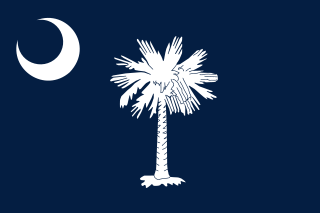
The flag of South Carolina is a symbol of the U.S. state of South Carolina consisting of a blue field with a white palmetto tree and white gorget. Roots of this design have existed in some form since 1775, being based on one of the first American Revolutionary War flags. While keeping most of its design intact since its adoption, it has varied over the years.
U.S. states, districts, and territories have representative symbols that are recognized by their state legislatures, territorial legislatures, or tradition. Some, such as flags, seals, and birds have been created or chosen by all U.S. polities, while others, such as state crustaceans, state mushrooms, and state toys have been chosen by only a few.

The Great Seal of the State of South Carolina was adopted in 1776. South Carolina's seal is made up of two elliptical areas, linked by branches of the palmetto tree. The image on the left is dominated by a tall palmetto tree and an oak tree, fallen and broken. This scene represents the battle fought on June 28, 1776, between defenders of the unfinished fort on Sullivan's Island, and the British Fleet. The standing palmetto represents the victorious defenders, and the fallen oak is the British Fleet. Banded together on the palmetto with the motto Quis separabit?, are 12 spears that represent the other original 12 states of the Union. Beneath that is enscrolled another of the alternate state mottoes, "Meliorem Lapsa Locavit" with the date of 1776. Surrounding the image, at the top, is "South Carolina", and below, is Animis opibusque parati. The other image on the seal depicts the Roman goddess Spes walking along a shore that is littered with weapons. The goddess grasps a branch of laurel as the sun rises behind her. Below her image is her name, Spes, Latin for 'hope', and over the image is the motto Dum spiro spero, meaning 'While I breathe, I hope'.

The South Carolina State House is the building housing the government of the U.S. state of South Carolina, which includes the South Carolina General Assembly and the offices of the Governor and Lieutenant Governor of South Carolina. Located in the capital city of Columbia near the corner of Gervais and Assembly Streets, the building also housed the Supreme Court until 1971.

Thomas Mitchell Poland is an American writer. He graduated from Lincoln High School in Lincolnton, Georgia. He earned a Bachelor of Arts in journalism and a master's degree in education from the University of Georgia. A frequent contributor to magazines, he has written approximately 1,200 features.

Sabal palmetto, also known as cabbage palm, cabbage palmetto, sabal palm, blue palmetto, Carolina palmetto, common palmetto, Garfield's tree, and swamp cabbage, is one of 15 species of palmetto palm. It is native to the far Southeast United States, the Yucatán Peninsula in Mexico, the West Indies, and the Bahamas.

The Carolina tartan is the official state tartan of both North Carolina and South Carolina. It was designed by Peter MacDonald of Crieff, Scotland, who registered it with the Scottish Tartans Society in 1981. The design was based on an early Royal Stewart tartan as part of the Royal Company of Archers uniform, believed to have been worn by King Charles I of England during his nuptial vows, giving it significance since The Carolinas were named for King Charles. It was made the official tartan of North Carolina in 1991 when it was passed by the North Carolina General Assembly. South Carolina followed suit, enacting legislation to make the Carolina tartan the official state tartan in 2002.

The following outline is provided as an overview of and topical guide to the U.S. state of Delaware:

The following outline is provided as an overview of and topical guide to South Carolina:
The following are minor or locally celebrated holidays related to the American Revolution.










